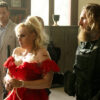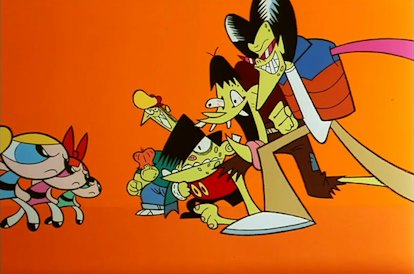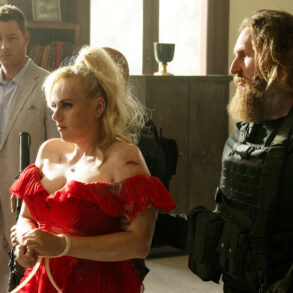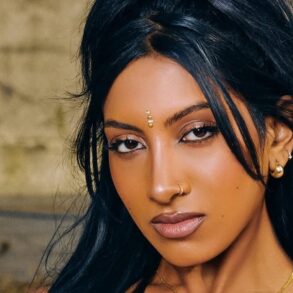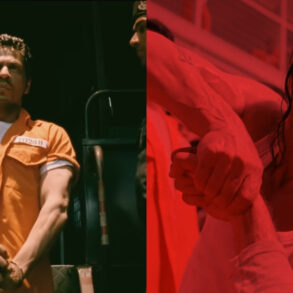Sugar, spice, and everything nice… those were the first pieces of the formula for one of Cartoon Network’s most popular shows, but it was missing one crucial element. When The Powerpuff Girls debuted 35 years ago on November 18, 1998, fans instantly fell in love with it. Starring three adorable superhero sisters thrashing gross monsters as tall as skyscrapers- while being incredibly funny doing it- the show connected with audiences in a special way. However, the secret origin story of this animated hit began with a concept very different from what viewers watched in ‘98, traveling a bumpy road on its way to becoming the classic fans still love today.
In the early 1990s, Craig McCracken was busy working on his sophomore animation project at the California Institute of the Arts, a short centered around a barrel-chested Mexican pro wrestler named “El Fuego.” In between figuring out this project, Craig made a birthday card for his brother with a trio of little girls inspired by the Big Eyes paintings of Margaret Keane. The more Craig drew what he described as “three cute little Sanrio-looking characters,” the more infatuated he became, and quickly shifted his attention to them. To McCracken, the idea of seeing these small girls fighting crime and pounding giant creatures into dust was hilarious, especially since mammoth titans like that shouldn’t be trounced so easily!
The first Powerpuff Girls short was completed in 1992 but had some key differences from the final product. In particular, the name. For whatever reason, Craig was obsessed with the term “opening a can of whoopass,” and thought it would be amusing to title his new creation accordingly. “The Whoopass Girls” were ready to take the screen, starring in their first short titled “Whoopass Stew! A Sticky Situation!”
A scene from the opening of the very first Powerpuff Girls short, before the characters were ever called that name
Cartoon Network/ Craig McCracken
While Professor Utonium, looking like an adult version of the lead from Dexter’s Laboratory, was laboring over a formula to create the perfect little girl, he accidentally added a can of “Whoopass” into his mixture. What exactly this can was, whether it be a drink, chili, or some kind of sludge, is never made clear. All that mattered was this odd substance caused an explosion that released three pastel-colored kids onto the scene.
The girls looked nearly identical compared to what aired six years later. Looking at them side by side, you’d notice very little differences from the final versions between Blossom, Buttercup, and… Bud? Craig imagined this sister differently than what we got and designated her with a masculine-coded label that didn’t stick.
If you were expecting the first bad guys these Whoopass Girls would face being Mojo Jojo or one of their other top-tier baddies, you’d be mistaken. The first half of this three-minute short saw the triplets make short work of the Rat Fink-inspired “Gangrene Gang.” They followed that smackdown with another round for “The Amoeba Boys,” ending with the girls brutally roasting these 1940s microbial gangsters on the sun.
McCracken left CalArts in 1993 to work at Hanna-Barbera Studios and developed his “Whoopass Girls” concept further in his spare time. After being rejected by Nickelodeon, Craig pitched it to his employers, who greenlit the cartoon for 13 episodes. However, a drastic change of plans occurred when the studio instead opted to produce it as a single short for Cartoon Network’s newest compilation show, World Premiere Toons (later renamed What A Cartoon!).
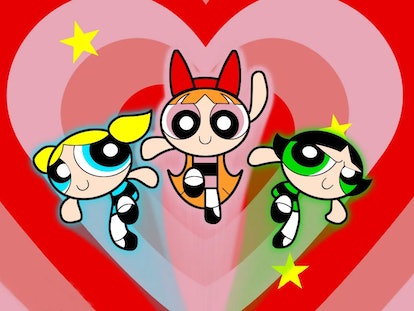



The Powerpuff Girls fight for truth, justice, and the ability to stay up past their bedtime
Cartoon Network/ Warner Bros. Discovery
While it wasn’t a full series, one episode was better than nothing. The next hurdle was that name. The network refused to let “Whoopass” be used on a kids’ cartoon, demanding it be renamed. After spitballing ideas to work around the censors while brainstorming more innocent-sounding titles, it came down to a singular idea that materialized from two of Craig’s friends, both independently coming to this title without conferring with each other- The Powerpuff Girls.
Their first pilot made for TV debuted on February 20, 1995, purposefully misspelled as “Meat Fuzzy Lumkins.” The villain here was Craig’s spin on a Sprite from Rainbow Brite as a redneck, whose ray zapped anything it blasted into meat. While Fuzzy went through a few small cosmetic changes along with adding a P to his last name, most everything else from the series was present. The City of Townsville, the Mayor, their kindergarten teacher Ms. Keane (named after the artist who inspired the look of the girls), and even the first appearance of Chemical X, replacing the can which shall not be named by censors.
Unfortunately for McCracken, “Meat Fuzzy Lumkins” wasn’t a hit, flopping with kids in marketing research focus groups. Craig redesigned the entire series, trying to address the complaints, but Cartoon Network reassured Craig to not change a thing. After a second pilot, the show was approved for a full-season run, and thus The Powerpuff Girls were born!
A clip from season 2’s “Slumbering With The Enemy”, where Mojo Jojo masquerades as a little girl to take down the girls during a sleepover with failed results
The Powerpuff Girls weren’t the only short premiering that night which doubled as proof-of-concepts. The same episode of World Premiere Toons also launched the careers of Craig’s CalArts classmate and producer on PPG, Genndy Tartakovsky, as well as Van Partible, whose respective shorts evolved into Dexter’s Laboratory and Johnny Bravo.
The strength of these ultra-powered little girls isn’t just in their formidable muscles but in their ability to stay fresh and relevant decades later. After six seasons and a movie with the original crew, followed by a reboot in 2016 for another three seasons, The Powerpuff Girls have become a mainstay for different generations of viewers. A live-action drama for The CW titled Powerpuff nearly came to fruition, but was permanently shelved after one of the stars exited the show, and a leaked script surfaced that caused massive fan backlash.
No matter what version audiences prefer, or what future incarnations may look like, all that matters is the day will always be saved by… The Powerpuff Girls!
The Powerpuff Girls are streaming on Max and available on DVD.
This post was originally published on this site be sure to check out more of their content.

